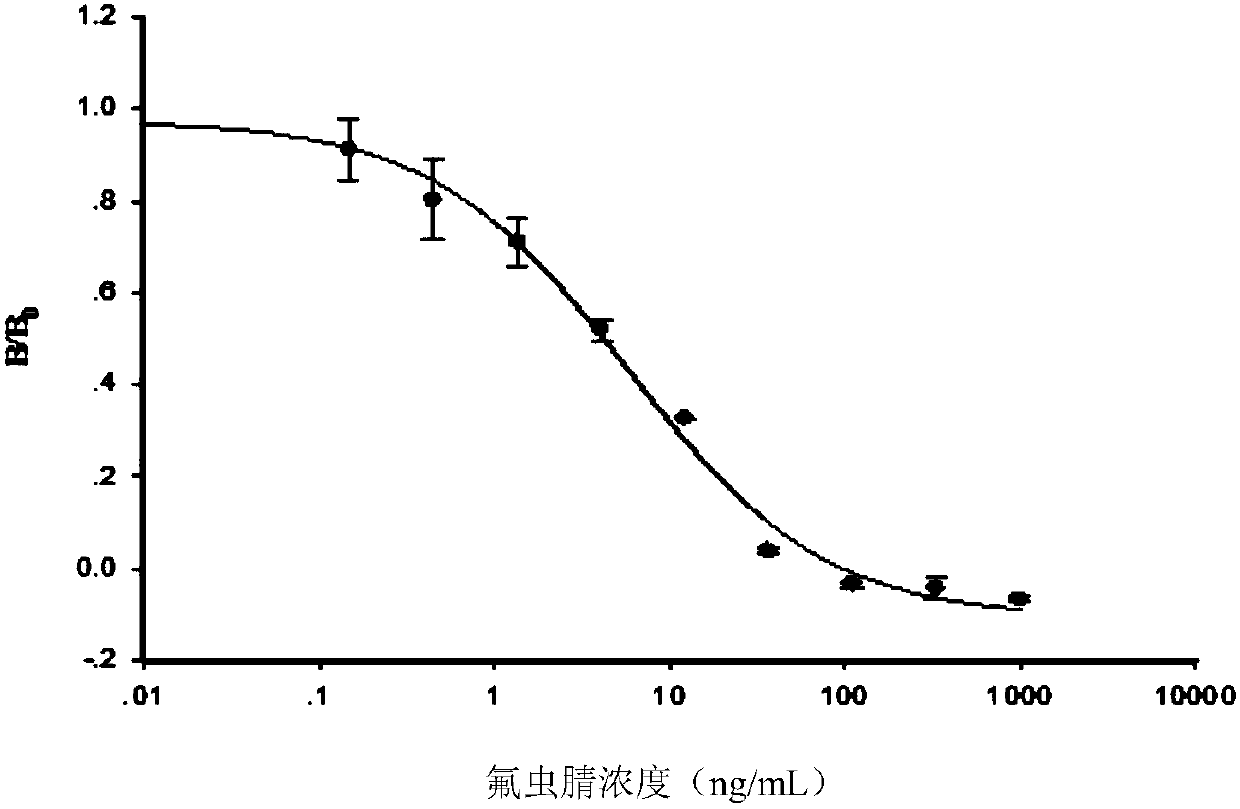ELISA kit for detecting fipronil residues on basis of nanobody and application of kit
A nanobody and kit technology, applied in the field of phage display technology, ELISA detection, and genetic engineering, can solve the problems of complex pretreatment, difficult on-site detection, and high cost of analysis methods, achieving less time-consuming, low sample detection cost, Simple pre-processing
- Summary
- Abstract
- Description
- Claims
- Application Information
AI Technical Summary
Problems solved by technology
Method used
Image
Examples
Embodiment 1
[0024] Example 1 Preparation of Fipronil Coating Antigen
[0025] The hapten and bovine serum protein are used to prepare the coupling complex as the coating antigen. The preparation method is as follows:
[0026] (1) Weigh 8.8mg 6-(3-cyano-5-(2,6-dichloro-4-(trifluoromethyl)phenyl)cyclopenta-1,3-dien-1-yl)amino )-6-oxohexanoic acid (MW=440.15) (0.02mmol), 2.65mg NHS (MW=115) (0.024mmol), 4.8mgDCC (MW=206) (0.023mmol) dissolved in 200μL anhydrous DMF, Stir at room temperature and react overnight. The reaction solution was centrifuged (5000rpm, 10min), the precipitate was discarded, and the supernatant was the active ester.
[0027] (2) Weigh 20mg BSA (MW=67000) dissolved in 2mL carbonate buffer solution (0.05mol / mL, pH9.5), add 150μL of active ester solution drop by drop with stirring, slowly, about 20-30min Finish adding. Then continue to stir the reaction at room temperature for 4-6 hours.
[0028] (3) The reaction solution is put into a dialysis bag and dialyzed with PBS (0.01...
Embodiment 2
[0029] Example 2 Construction of Fipronil Phage Display Nanobody Library
[0030] The active ester method is used to couple the hapten to keyhole limpet hemocyanin. The specific method is as follows:
[0031] (1) Weigh 66.02mg 6-(3-cyano-5-(2,6-dichloro-4-(trifluoromethyl)phenyl)cyclopenta-1,3-dien-1-yl)amino )-6-oxohexanoic acid (MW=440.15)(0.15mmol), 17.825mg NHS(MW=115)(0.155mmol), 31.518mg DCC(MW=206)(0.153mmol) dissolved in 1500μL anhydrous DMF , The reaction was stirred overnight at room temperature. The reaction solution was centrifuged (5000rpm, 10min), the precipitate was discarded, and the supernatant was the active ester.
[0032] (2) Take 6 mL of KLH solution (6.8 mg / mL), add 1200 μL of active ester solution dropwise with stirring, and slowly add it in about 20-30 minutes. Then continue to stir the reaction at room temperature for 4-6 hours.
[0033] (3) The reaction solution is put into a dialysis bag and dialyzed with PBS (0.01mol / L pH7.4). Change the fluid every 6-8...
Embodiment 3
[0062] Example 3 Screening of Specific Fipronil Phage Display Nanobody
[0063] Coat the coating antigen of Example 2 in the first well of a 96-well microtiter plate at a concentration of 100 μg / mL at 4°C overnight; the next day, pour out the coating solution and wash with PBST for 3 times. Block the first and second wells of the target plate with BSA and incubate at 37°C for 1 hour; pour out the blocking solution and wash with PBST 3 times; add the phage antibody library of Example 2 to the first well and react for 2 hours; pour out the liquid, Pat dry on clean absorbent paper, wash with PBST 5 times; add 100μL fipronil standard to the first well, react for 1h; aspirate the liquid in the first well, add to the second well, react for 1h, Remove the phage bound to BSA; collect the eluate, take 5 μL for titer determination, and use the rest for amplification.
[0064] Add the phage eluate to fresh E. coli ER2738 bacterial solution, and let it stand for 15 min at 37°C; add carbenicil...
PUM
 Login to View More
Login to View More Abstract
Description
Claims
Application Information
 Login to View More
Login to View More - R&D Engineer
- R&D Manager
- IP Professional
- Industry Leading Data Capabilities
- Powerful AI technology
- Patent DNA Extraction
Browse by: Latest US Patents, China's latest patents, Technical Efficacy Thesaurus, Application Domain, Technology Topic, Popular Technical Reports.
© 2024 PatSnap. All rights reserved.Legal|Privacy policy|Modern Slavery Act Transparency Statement|Sitemap|About US| Contact US: help@patsnap.com










